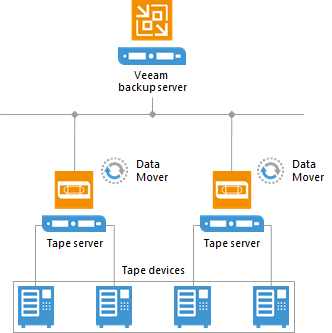 This is an archive version of the document. To get the most up-to-date information, see the current version.
This is an archive version of the document. To get the most up-to-date information, see the current version.Tape Device Deployment
Tape devices are connected to Veeam Backup & Replication via a tape server. As a tape server, you can use any Microsoft Windows server managed by Veeam Backup & Replication. In small installations, you can connect the tape device or devices to the Veeam backup server and assign the role of the tape server to it. The tape connected devices are recognized by the Veeam Backup & Replication automatically.
Tape traffic loads the tape server a lot. Using the Veeam backup server as the tape server may be sufficient for small environments with low traffic workloads. However, if you plan to back up data to tape intensely, consider allocating a dedicated tape server to offload the Veeam backup server. You can also reconnect your tape device to a dedicated tape server. After the tape device is reconnected, the tape infrastructure appears in Veeam Backup & Replication unchanged.
Using a separate tape server is useful in the following cases:
- To balance the traffic load in installations with intense data transferring,
- To configure remote data archiving: you can connect the tape devices to any tape server accessible by Veeam Backup & Replication by network.
- To deploy a number of tape servers managed by one Veeam backup server.
With Veeam Backup & Replication, the data transfer during archiving and restore processes is enabled with Veeam Data Mover services. The Data Movers run on tape servers and other components of backup infrastructure. They receive tasks from the Veeam backup server and communicate to each other to transfer the data.
The Data Movers are light-weight services that take a few seconds to deploy. Deployment is fully automated: when you assign a tape server role to a server, Veeam Backup & Replication installs the necessary components on this server and starts the required services on it.
You can connect the tape device to the tape server directly over Fibre Channel (FC), Serial Attached SCSI (SAS), SCSI or remotely with iSCSI (you can use Microsoft iSCSI initiator to establish the connection).

Veeam Backup & Replication allows deploying a number of tape servers. You can connect one or several tape devices to one tape server. However, you cannot connect one tape server to several Veeam backup servers simultaneously.
|
You can easily reconnect a tape server to another Veeam backup server without reconfiguring the tape device. Veeam backup server will recognize the library settings automatically. After reconnecting the tape library, you must configure backup to tape or file to tape jobs anew or copy the Veeam Backup & Replication database configuration file on the new Veeam backup server. For more information, see Performing Configuration Backup and Restore. |
Upgrading Existing Tape Installations
If you have used Veeam Backup & Replication v7 to work with tape media, the Veeam Backup & Replication database has information about previously connected tape devices. During upgrade, Veeam Backup & Replication will automatically reconfigure the tape device connection and assign the role of the tape server to the Veeam backup server.
Related Topics